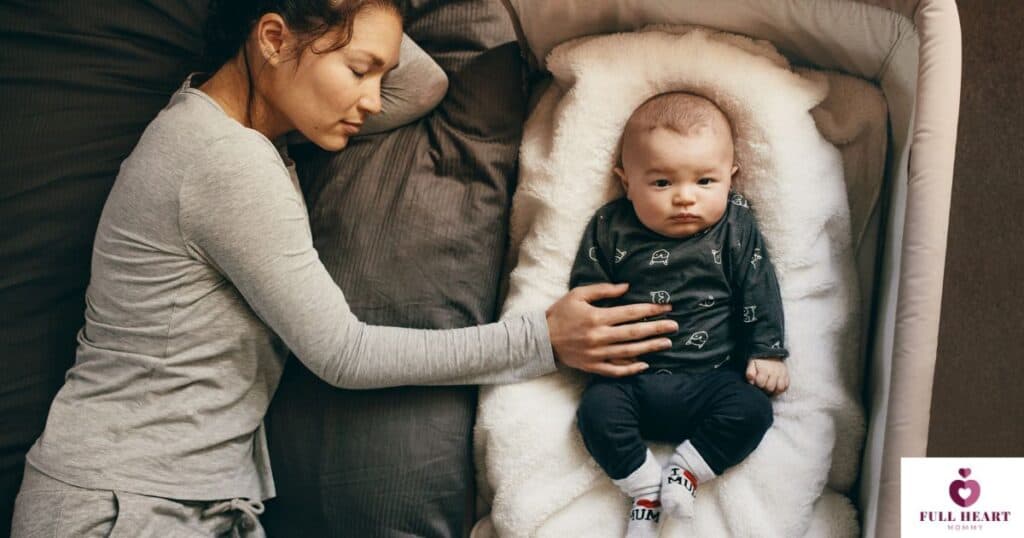Are you wondering what cosleeping means? Co-sleeping is a practice in which babies and young children sleep close to one or both parents, as opposed to in a separate room.
Co-sleeping individuals sleep in sensory proximity to one another, where the individual senses the presence of others. This sensory proximity can either be triggered by touch, smell, taste, or noise.
There are many different ways babies or children sleep in close emotional and physical contact with their families, usually within arm’s reach.
Whether it is for protection, warmth, ease of nursing, or comfort, some families routinely sleep side-by-side. Co-sleeping essentially means sleeping in close proximity to your child.
It may be in the same bed or just in the same room.
What does cosleeping look like?
Some ways of co-sleeping that different families use are:
- Parent(s) sleep in the same bed with the child
- Securely attach a crib to one side of the parent’s bed, next to the mother
- Have three sides of the baby’s crib attached to the parent’s bed
While some people believe that co-sleeping is beneficial for the child’s emotional and physical development, others argue that it may increase the risk of sudden infant death syndrome (SIDS) and other sleep-related risks.
The American Academy of Pediatrics warns against bed-sharing because it increases a baby’s risk for SIDS. It is important to weigh the pros and cons of co-sleeping and make an informed decision based on your family’s needs and circumstances.

What is Co-Sleeping?
Just what is considered cosleeping? Co-sleeping refers to the practice of sleeping in close proximity to your baby, sometimes in the same bed and sometimes nearby in the same room (room-sharing).
Co-sleeping can be divided into two categories: bed-sharing and room-sharing.
Co-Sleeping vs. Bed-Sharing
Bed-sharing is a form of co-sleeping where the baby sleeps in the same bed as the parents. While bed-sharing can be a convenient way for parents to bond with their baby, it is not recommended by the American Academy of Pediatrics (AAP) due to the increased risk of Sudden Infant Death Syndrome (SIDS) and suffocation.
Bed-sharing can also increase the risk of accidental smothering and children falling off the bed.
Room-Sharing vs. Bed-Sharing
Room-sharing is a form of co-sleeping where the baby sleeps in the same room as the parents but in a separate crib or bassinet.
The AAP does recommend room-sharing for at least the first six months of a baby’s life, as it has been shown to decrease the risk of SIDS by as much as 50%.
Room-sharing allows parents to keep a close eye on their baby without the risks associated with bed-sharing.
When room-sharing, it is important that the baby’s crib or bassinet is placed in a safe location. There are baby beds designed for cosleeping. Are cosleepers safe? Well, they can be if used properly.
The crib or bassinet should be placed away from any potential hazards, such as cords, blinds, or heaters.
The crib or bassinet should be placed on a flat surface and should not be placed on top of any soft surfaces, such as a bed or couch.

Benefits of Co-Sleeping
Here are some of the physical and emotional benefits of co-sleeping:
Physical Benefits
Co-sleeping can provide physical benefits for both you and your baby. When you sleep close to your baby, you can easily respond to their needs, such as feeding, comforting, and changing.
This can result in more sleep for both you and your baby. You can cut down on the trips to another room, and the groggy sleep deprived walks in the middle of the night.
You probably are struggling to sleep anyway, terrified that you won’t hear your baby when they cry, but with this option, you should certainly hear them.
Studies have also shown that co-sleeping can help regulate your baby’s body temperature and breathing, which can reduce the risk of Sudden Infant Death Syndrome (SIDS).
Additionally, co-sleeping can help promote breastfeeding. It makes it much easier for your baby to have access to you and latch on when they need to.
Emotional Benefits
When you sleep close to your baby, you can develop a stronger bond with them. This can help promote a sense of security and attachment, which can contribute to your baby’s emotional development.
Co-sleeping can also help reduce stress and anxiety for both you and your baby.
When your baby is close to you, they can feel more comforted and secure, which can help them sleep better.
This, in turn, can help reduce your stress and anxiety levels, as you will be able to respond to your baby’s needs more easily.
In addition, co-sleeping can promote attachment parenting, which emphasizes the importance of responding to your baby’s needs and building a strong emotional bond with them.

Controversy Surrounding Co-Sleeping
Even with all benefits considered, cosleeping is an extremely controversial topic among parents, pediatricians, and experts. Just take a look around at the many hot debates that go on about this online!
Opposing Views
There are two opposing views on co-sleeping. Some parents believe that co-sleeping is a personal decision that should be made based on their family’s needs and preferences.
They argue that co-sleeping can help parents get more sleep, promote bonding between parent and child, and make breastfeeding easier.
On the other hand, some experts believe that co-sleeping is never safe and should be avoided at all costs.
Safety Concerns
As we have stated before, one of the main safety concerns associated with co-sleeping is the risk of Sudden Infant Death Syndrome (SIDS).
Studies have shown that infants who co-sleep with their parents are at a higher risk of SIDS than infants who sleep alone in a crib or bassinet.
Other safety concerns include accidental suffocation, strangulation, and injury from falling out of bed.
Parents who are under the influence of drugs or alcohol should never co-sleep with their infant, as it can increase the risk of involuntary manslaughter.
Safe Sleep Recommendations
When it comes to co-sleeping, it is important to follow safe sleep recommendations to reduce the risk of sudden infant death syndrome (SIDS) and other sleep-related accidents.
Here are some guidelines to keep in mind:
American Academy of Pediatrics Guidelines
The American Academy of Pediatrics (AAP) recommends that infants sleep on their backs on a firm, flat surface, free of any soft objects or loose bedding.
This is the safest sleep position for infants and reduces the risk of SIDS. The AAP also recommends that infants sleep in the same room as their parents, but not in the same bed.
Room-sharing can make it easier to breastfeed and monitor your baby, but bed-sharing can increase the risk of suffocation, strangulation, and entrapment.
Centers for Disease Control and Prevention Recommendations
The Centers for Disease Control and Prevention (CDC) also recommends that infants sleep on their backs on a firm, flat surface, free of any soft objects or loose bedding.
They also advise against bed-sharing, as it increases the risk of sleep-related accidents.
The CDC recommends that infants sleep in a separate crib, bassinet, or play yard in the same room as their parents for at least the first six months of life.
It is important to note that while co-sleeping can be a very individualized and personal choice, it is crucial to prioritize your baby’s safety when making decisions about sleep arrangements.

Co-Sleeping with Infants
Cosleeping with very young babies does have its share of benefits.
Feeding and Co-Sleeping
Co-sleeping can make breastfeeding easier and more convenient. You can easily attend to your baby’s needs without having to get out of bed.
If you are formula feeding, it can still help make feeding easier simply based on the proximity to your baby.
Now you (or the other parent) may have to get up to warm or prepare a bottle, but since your baby is closer you can anticipate these needs rather than wait to hear a hungry cry from another room.
It also promotes bonding between the mother and the baby. However, it is important to be aware of your baby’s feeding needs and position them correctly to avoid suffocation.
Bedding and Co-Sleeping
When co-sleeping with your infant, it is important to use a firm surface, such as a mattress, and avoid couches or other soft surfaces.
I avoided falling asleep on the couch with my baby for many months after my daughter was born because it was just a little too comfy and I feared her rolling into a crevice.
Pillows, blankets, and stuffed animals should be kept away from the baby to prevent suffocation or strangulation. I know doc a tot and other alternative sleep loungers have been a hot topic, but these types of baby pillows are not used for unsupervised baby sleep.
Additionally, make sure the baby is positioned away from the edge of the bed to avoid falling off.

Co-Sleeping with Toddlers
Co-sleeping with toddlers is a practice where parents share a bed with their child for all or part of the night.
Now that your baby is a little older, sleeping with a toddler can be an experience.
They move a LOT. You may not have even planned on them sleeping with you but they keep climbing out of their crib.
It is a personal choice and not for every family, but those who choose to snooze with a toddler tucked into an arm nook know that it can be a comforting and bonding experience.
It’s like that odd sensation or feeling that comes over you when you’re looking at them and your toddler is the most adorable person ever, even after you’ve been wishing they would just go to sleep all day!
Pros and Cons of Co-Sleeping with Toddlers
There are both advantages and disadvantages to co-sleeping with toddlers. Here are some pros and cons to consider:
Pros
- Bonding: Co-sleeping can help strengthen the bond between parents and toddlers.
- Convenience: It can be convenient to have your child at arm’s length, especially for breastfeeding mothers.
- Reduced stress: Co-sleeping can reduce stress around falling asleep or waking during the night.
- Cultural norm: Co-sleeping is a cultural norm in many parts of the world.
Cons
- Sleep training: Co-sleeping can make it difficult to sleep train your toddler.
- Noise: Toddlers can be noisy sleepers, which can disrupt your sleep.
- Independence: Co-sleeping can make it harder for toddlers to develop independence and learn to sleep on their own.
- Safety concerns: There is still a risk of smothering, strangulation, and suffocation when co-sleeping with a toddler.
Transitioning from Co-Sleeping
If you have decided to stop co-sleeping with your toddler, it is important to do it gradually and with patience. Here are some tips to help with the transition:
- Create a consistent bedtime routine.
- Make your toddler’s bedroom a comfortable and inviting space.
- Use a transitional object like a lovey which can be a favorite stuffed animal or blanket.
- Be patient and consistent.
Ultimately, I cannot decide if cosleeping is right for you and your family. There will come a time when this may not even be an issue for you.
I don’t judge anyone for doing what they have to do to get more rest for everyone. Just be sure to weigh the pros and cons.
Make sure that you’re taking the best safety precautions possible. Best of luck to you and happy parenting. You got this!
FAQs about Cosleeping
At what age should you stop co-sleeping with your child?
Some choose to end co-sleeping when their child is a few months old, while others continue until their child is several years old. But when it comes to stopping, the truth is, there’s no one right answer for everyone. The decision should be based on what’s best for your family. As your child grows and develops their own sleep habits, you may find that naturally, your child becomes more comfortable sleeping on their own.
Why does my child have to touch me when he sleeps?
It’s not uncommon for children to want to touch or cuddle with their parents when they sleep. For children, this instinct can provide a sense of security and comfort, especially if they’re feeling anxious or fearful. It’s important to remember that children are still developing emotionally and mentally, and sometimes they need that extra closeness to feel safe and secure.

